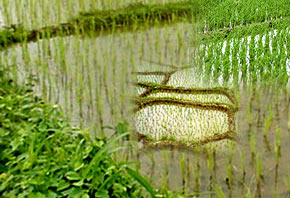|
Pakistan: the fastest rice producing country in Asia
ARTICLE (May 21 2003) : Pakistan is located between 24 degree and 36 degree N latitude and 62 degree and 76 degree E longitude The wedge shaped country is bounded on the south of Arabian Sea, on the south-west by Iran, on the north-west by Afghanistan, on the north-west by the Republic of China, and on the east by India. Elevation ranges from sea level on the Arabian Sea to over 7600 meters in the north.
The country may be roughly divided into three geographical regions: the highlands, where the western extension of Himalayan mountains meets that of the Hindu
Kush: the vast, lightly populated south-western plateau and the mountains on the north and north-western flank of the country: and the upper and lowers plains of the Indus River.
Pakistan lies in the AEZ 5, characterised as warm arid and semiarid subtropics with summer rainfall. Climate varies from north to south over different periods of the year, but the country is generally arid.
There are four seasons: a relatively dry-cool winter from December through March, the dry-hot summer from April through June, the summer rainy season or south-west monsoon from July through September, and the retreating monsoon period of October and November.
Average rainfall is around 250-500 mm in the upper Indus River plains and part of the western plateau, only 125-250 mm in the lower Indus River Plains and most of the South-western plateau, and around 500-1000 mm in the Northern high altitudes.
About 80 percent of the annual rainfall comes during July and August. The population of the country is more than 130 million. About 68 percent of the people live in rural areas, although the proportion is slowly decreasing. About 52 per cent of the population is engaged in agriculture. With a population growth 2.9 per cent per year, Pakistan is the fastest rice-producing nation in Asia.
Importance of Rice: The economy of Pakistan is still largely based on agriculture. About 26 per cent of the GDP was generating in the farming sector. Wheat is the staple crop providing, about of the half of the daily calorie intake.
Rice provides only 8 percent of the daily calories intake. Annual per capita consumption of wheat is 124 kg/yr compared with only 10 kg/yr for rice. Unlike in other South and South-east Asian countries, rice is not considered a subsistence crop in Pakistan.
It is a cash crop grown for export. Rice is the third major crop, after wheat and cotton, in the contribution to GDP originating from agriculture. It contributes 13 per cent while wheat and cotton each contributes around 30 percent. Rice is the second major crop in its contribution to export earnings from raw material, contributing about nine per cent per year to foreign exchange earnings from raw items.
Pakistan exports about two million tones of rice is about 10 per cent of the world rice trade. The export of long grained, aromatic, fine quality rice (called basmati) goes mainly to Middle East market while long grain non-aromatic rice are exported each year to South and South-east Asia.
Rice Environment: Rice occupies about 25 per cent of the cultivated area in the summer monsoon season and 10 percent of the total cropped area. Wheat, being the staple food, occupies 75 percent of the cultivated areas in the winter season and about 38% of the total cropped area.
Of the nearly 20 million hectares of cultivable land, 16.5 million hectares are irrigated. Crop production on the remaining area depends mainly upon rainfall. As in many other sites in South Asia, rice cultivation in Pakistan generally follows a wheat crop on the same peril.
Production Constraints: Despite a fairly sable irrigation water supply, rice yields are low for both traditional basmati and non-basmati. There is a potential for about 25% higher yields at the present level of inputs.
This potential can be achieved by advancing farm-management practices through improved institutional functioning, access to infrastructure and developing technologies consistent with farm conditions. Of more immediate concern is sustaining yields, even at the current level. Rice yields of non-basmati are stagnating and those of basmati rice are declining.
The reasons for stagnating or declining yields are thought to be the increasing incidence of salinity caused by injudicious use of irrigation water, mismanagement in the use of inputs such as
fertiliser, unfit under ground water, soil nutrient depletion, the development of insect-pest and weed complexes peculiar to the rice - wheat system and inadequate economic incentives for long-term investments in land and soil improvements.
Production Opportunities: Pakistan has strong rice research programmes at the national and provincial levels. At the national level, the Rice Co-ordination Programme in the Pakistan Agricultural Research Council co-ordinates provincial research activities to the international agricultural research centres such as IRRI and the International Irrigation Management
(IIMI).
Recently, the Kala Shah Kakuo Research Institute offered farmers in Punjab a fertiliser responsive, short-duration, highly-yielding, basmati rice variety, which increases the time available for land preparation for wheat after rice.
The Dokri Rice Research Institute works to improve post harvest processing, soil fertility, rice - wheat system and insect management. IIMI is working on water management issues to address water logging and salinity problems.
Pakistan has strong collaborative programmes with IRRI through the rice - wheat project funded by the Asian Development Bank. Sustainability issues and new technologies are being tested for the site-specific environments. The rice - wheat collaborating countries (Bangladesh, India, Nepal and Pakistan) share each other's experience.
Source: Business
Recorder
|
Pakissan.com;
|